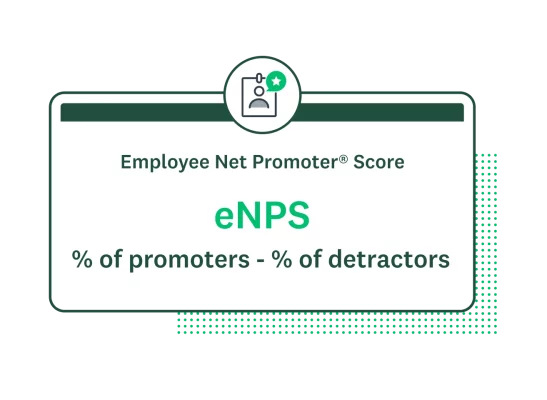What is employee Net Promoter Score®?

Unlocking the secret to employee engagement starts with one simple question asking how likely employees are to recommend your organization as a great workplace.
Employee disengagement negatively impacts productivity and fuels attrition. In a landscape where only one-third of HR professionals excel in reducing turnover, the employee Net Promoter Score® (eNPS) effectively measures workplace sentiment and gathers feedback, providing insights to improve satisfaction and retention.
What is eNPS®?
The eNPS® is the industry standard metric for measuring employee satisfaction and engagement. It’s based on a single, direct question: “On a scale of 0 to 10, how likely is it that you would recommend working at this company to a friend or colleague?"

Employees rate their likelihood on a scale from one to ten. The eNPS® rating scale then categorizes employees into three segments: detractors, passives, and promoters.
- Detractors (0-6): These unsatisfied employees are unlikely to recommend the company—their feedback signals areas requiring immediate improvement to prevent turnover and negative word-of-mouth.
- Passives (7-8): Passive employees are neutral—satisfied but not enthusiastic about the workplace. While not detrimental, their lack of strong loyalty indicates missed opportunities for engagement and motivation.
- Promoters (9-10): Promoters are your company's best advocates. They’re highly satisfied and will likely recommend your workplace, contributing positively to the company's reputation and growth potential.
This scale captures diverse employee sentiments toward their workplace, from highly enthusiastic to critical. By simplifying the feedback mechanism to a single metric, eNPS® allows organizations to gauge the overall health of their employee experience quickly.
The eNPS® is the foundation for more detailed analysis and actions, setting the stage for deeper insights into employee engagement and loyalty trends—typically through further research, such as employee surveys or interviews.
What’s the difference between NPS® and eNPS®?
eNPS® mirrors the Net Promoter Score® system created by Bain & Company and Fred Reichheld. Bain & Company designed the NPS® framework to assess customer loyalty, which HR professionals have adapted to evaluate employee experience.
Why is eNPS® so important?
The eNPS® provides crucial insights into employee sentiment. Employees are the face of your organization, driving customer relationships and overall market presence. Here's why it matters:
eNPS® can help improve retention
Addressing employee turnover remains a top concern for HR professionals. eNPS® can identify root causes and inform strategies to improve retention. For example, eNPS scores can highlight employee dissatisfaction with compensation or benefits, prompting an organization to strengthen its current offerings.
eNPS® can turn employees into brand ambassadors
eNPS® reflects how likely your team is to recommend your organization as a great workplace. This sentiment directly indicates your internal brand health and employee advocacy.
Employees naturally discuss their work experiences with friends, family, and on social media. When they are satisfied and engaged, they become organic promoters of your company. Disengaged employees, on the other hand, can spread negativity or apathy, which can detrimentally impact your brand.
eNPS® supports strategic HR decision-making
Instead of relying on attrition rates, eNPS® offers a clear, quantifiable measure of employee engagement. It serves as a cornerstone for strategic HR planning and improvement initiatives. HR professionals can use this data to address potential issues proactively before they escalate.
Data from a recent SurveyMonkey report underscores the importance of eNPS® in navigating HR challenges and leveraging opportunities:
- HR's strategic influence: Organizations that view HR as vital report a stronger role in shaping company culture and decision-making, significantly impacting the overall employee experience.
- Feedback and engagement: In the post-pandemic era, 73% of HR professionals in organizations where HR is vital see an increased role in employee experience management, emphasizing the importance of feedback tools like eNPS®.
- Expectations vs. investment: Despite higher expectations from leadership, 19% of HR professionals believe their companies underinvest in employee development. A robust eNPS® program can highlight investment areas to meet these growing expectations.
How to calculate eNPS®

The employee NPS® uses the same calculation system as NPS®. Start by converting the number of detractors, passives, and promoters you have into percentages.
Subtract the percentage of detractors from the percentage of promoters. Ignore passives, as they don't affect the score directly.
For example, if 30% of respondents are promoters and 20% are detractors, your eNPS® is 10 (30% - 20% = 10).
What is a good eNPS® score?
eNPS® scores range from -100 to 100, but most companies rarely score above 30.
- Negative scores: A negative score suggests that detractors outnumber promoters, suggesting widespread dissatisfaction and potential issues with company culture, management, or employee engagement.
- 0-10 (acceptable): This range suggests a balanced split between promoters and detractors. While not alarming, there is a need for improvement.
- 10 to 30 (Good): This range reflects a positive work environment with healthy employee engagement and satisfaction. It is considered good across industries.
- 30 to 50 (Very good): Scores in this bracket are above average and indicate a robust and positive employee sentiment towards the organization. It suggests that effective strategies are in place to promote employee engagement and loyalty, leading to most employees being promoters.
- 50+ (Excellent): An excellent eNPS® score showcasing an exceptional employee experience significantly exceeding industry averages. Organizations with scores have cultures that actively promote and support employee advocacy.
It's important to note that eNPS® benchmarks can vary significantly across different industries. A good score in one sector might be average in another.
For example, industries with traditionally lower employee satisfaction rates may view a score of 20 as positive. In contrast, more competitive sectors might aim for scores of 50 or higher to reflect their stronger focus on employee experience and engagement.
eNPS is a quantifiable snapshot of your employee satisfaction, but it’s important to combine your score with other types of employee feedback to get a complete picture of employee loyalty and engagement.
How to improve employee Net Promoter Score®
Use follow-up surveys
Supplement the standard eNPS® question with other eNPS® questions and follow-up employee feedback surveys that probe the reasons behind the scores. Use anonymous surveys to encourage honest, unfiltered feedback.
Related: Creating anonymous employee surveys
Target key areas for impactful change
Analyze eNPS® feedback to identify high-impact areas for improvement, such as hiring and onboarding to building and maintaining an inclusive workplace.
Prioritize actions based on feedback trends and potential impact on employee satisfaction and engagement, starting with areas directly affecting day-to-day employee experiences.
Stay informed of HR trends
Regularly research and implement current HR trends and opportunities, such as flexible work arrangements, employee wellness programs, and modern learning and development tools.
Establish consistent eNPS® measurement intervals
Conduct eNPS® surveys regularly (e.g., quarterly or bi-annually) to monitor trends and measure the impact of changes. Schedule surveys in advance and integrate them into the company calendar to ensure consistent participation and timely analysis.
Centralize employee experience management
Track and manage employee experience, from feedback collection to analysis, to simplify eNPS® procedures.
Choose a platform that streamlines employee engagement with intuitive tools and resources, including pre-written survey templates and expert-written questions, to create and distribute surveys effortlessly.
Discover valuable employee insights with SurveyMonkey
Incorporating eNPS® into your HR strategy helps retain top employees while attracting new talent, making it a pivotal tool in today's competitive labor market. Regularly tracking eNPS® helps maintain a pulse on employee engagement, ensuring that initiatives align with employee needs and expectations.
Discover more resources

HR toolkit: Make employee experience your competitive advantage
HR leaders can use this toolkit to help drive exceptional employee experiences.

How feedback drives organizational transparency and builds trust
Support organizational transparency by making sure all stakeholders have access to relevant, honest information

eNPS Benchmarks: Measure and Improve Employee Engagement
Understand what makes a good eNPS, how to measure it, and discover effective strategies to increase employee engagement and retention.

Employee satisfaction: Why it matters and how to improve
Satisfied employees are happier and more productive. Learn how to measure and boost employee satisfaction to create a workplace people love.
Take the first step to transforming employee engagement
Create an eNPS® survey in minutes to discover your organization's score.
Net Promoter, Net Promoter Score, and NPS are trademarks of Satmetrix Systems, Inc., Bain & Company, Inc., and Fred Reichheld.